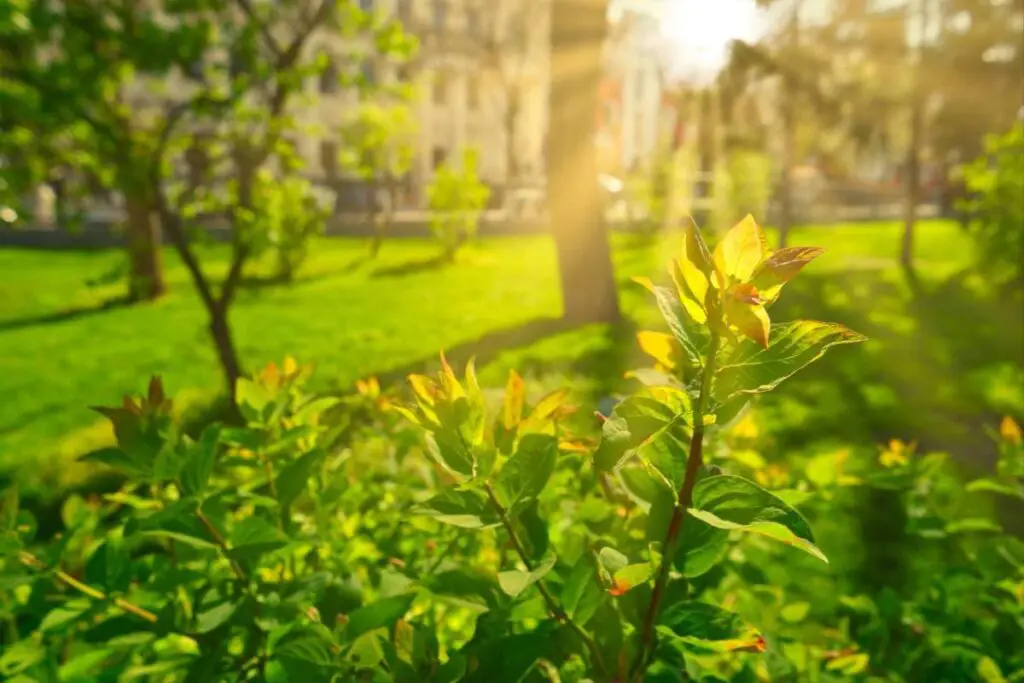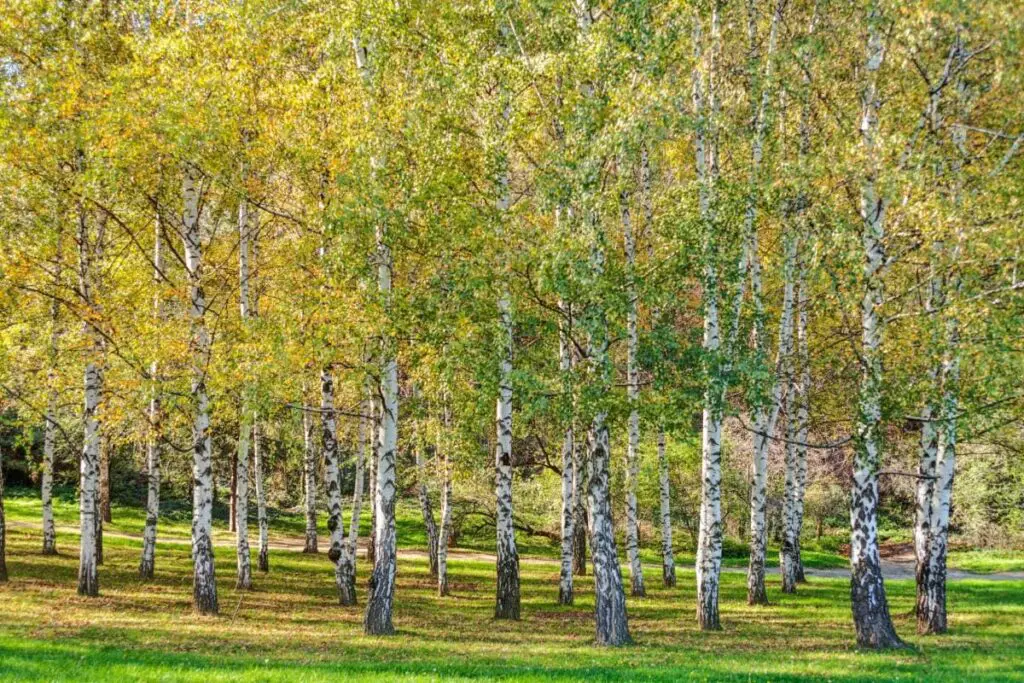The environment is paying the price for the pollution created by human activity. While lawmakers debate green policies worldwide, environmental pollution continues to worsen. But we don’t need to wait for laws to be enacted to do something about it. Knowing which outdoor plants that help reduce air pollution is a good start.
Plants reduce air pollution through photosynthesis, transpiration, and pollution absorption. Some examples of outdoor plants that reduce air pollution are Lady Palm, English Ivy, Peace Lily, and Boston Fern. Trees known as great de-polluters include Norway Maple, Silver Birch, and Turkey Oak.
In this article, we will get better acquainted with important outdoor plants that can help environmentalists, scientists, and other concerned citizens save our planet. Read on to learn more about these plants that help to clean the air.

What Is Air Pollution?
According to the World Health Organisation, air pollution is contamination of the indoor or outdoor environment by any chemical, physical or biological agent that modifies the natural characteristics of the atmosphere.
World Health Organisation
The WHO names familiar sources of pollution such as:
- industrial facilities
- household combustion devices
- motor vehicles, and
- forest fires
The natural environment is paying the price for modern convenience and consumerism. However, nature might hold the solution. From the plants mentioned in this article, you will better understand nature’s role in the quest to reduce air pollution and ensure the survival of the planet’s ecosystems.
How Outdoor Plants Reduce Air Pollution
Before getting to know the miracle-working plants, we need to understand how they de-pollute the air as well as producing oxygen. Plants help improve the quality of air through these mechanisms:
- Photosynthesis
- Transpiration
- Pollution Absorption
Photosynthesis Is an Air-Purifying Process
Photosynthesis is a process by which plants utilise sunlight to synthesise food from carbon dioxide and water. Unlike animal species, they are mostly incapable of heterotrophic feeding, so they need to produce their own food (of course this excludes carnivorous plant species, like the Venus Flytrap, that feed on insects).
A crucial part of photosynthesis is plants’ uptake of carbon dioxide, a greenhouse gas. Plants draw carbon dioxide from the air into the plant cell, where a dance occurs between water and carbon dioxide. Water is oxidised, which means it loses two electrons. At the same time, carbon dioxide is reduced, or in simple terms, it gains two electrons.
This process transforms water into oxygen and converts carbon dioxide into glucose. The cherry on top, oxygen, is a by-product of the photosynthetic process. By this mechanism alone, it is evident how important outdoor plants are in combating the effects of pollution on the quality of air and, ultimately, the health of human, animal, and plant populations.

Transpiration Improves Air Quality
Through transpiration, plants take up water through the roots and release water vapour through pores found on the underside of leaves into the atmosphere. Many of the pollutants in the air have a drying effect on the membranes of our airways. The vapour dispensed through transpiration increases the humidity in the air, which makes it more comfortable to breathe in.
Air Pollution Absorption Capabilities of Plants
In 1989, NASA researchers looking for ways to detoxify the air in space stations found that plants can scrub the air of carcinogenic compounds such as formaldehyde and benzene. Later research also found that potted plants’ soil microorganisms play a role in cleaning the air.
However, some experts challenged the findings. They claimed the plants used in the experiments were grown in optimum conditions. Therefore their toxin-degrading capabilities were enhanced.
Most were critical of the theory because indoor conditions are just sufficient enough for photosynthesis to happen. So there is not enough scientific evidence to support the claim that plants can detoxify air under less than optimum conditions.
Types of Plants That Reduce Air Pollution
With a better understanding of how plants improve the quality of air, you can acquaint yourself with the frontrunners in the race to save our planet, one plant at a time. Plants are usually differentiated by size, life cycle, and hardiness zones.
Plant Type by Size
- Herbs – Considered the smallest in size
- Shrubs – Bigger than herbs with hard stems
- Trees – Biggest of plants
- Creepers – Creep the ground, have thin, long stems
- Climbers – Grow vertically with external support, have thin, weak stems
Plant Type By Life Cycle
- Ephemeral – Have a short life cycle spanning only a few weeks
- Annual – Sustained for only a year, example are crops
- Biennial – Biological cycle of growth requires two years; the first year for growth, and start dying on the second year
- Perennial – Have the longest lifespan, growing continuously for several years
The 3 Groups that Clean the Air
- Small Plants
- Large Plants
- Trees
Small Plants
| Name | Type by Size | Type by Life Cycle | Hardiness Zones |
| Lady Palm | Shrub | Annual | 9-11 |
| Gerbera Daisy | Herbaceous | Perennial | 8-10 |
| Variegated Spider Plants | Herbaceous | Perennial | 9-11 |
| Poinsettia | Shrub | Perennial | 9-11 |
- Lady Palm – The Lady Palm is native to China and belongs to a small palm species. It has slender, upright green stems that grow in dense clumps. It requires only partial sun exposure and can even thrive in the shade, making it highly adaptable to the indoors. It blooms in the spring and is easy to grow.
- Gerbera Daisy – Native to South Africa, the Gerbera Daisy has a reputation for being so vividly coloured that they sometimes look artificial. They have distinct large flower heads and vibrant petals around a center disk of black flowers. They are typically grown as annuals; but they are perennials in warmer states.
- Variegated Spider Plants These warm-weather perennials are not as bad as they sound. When grown in conditions that mimic their native environment, they can become quite stunning. Slender, arching, striped leaves also make them beautiful additions to your home’s decor.
- Poinsettia – Poinsettias are considered holiday plants and are a common sighting during the Christmas season. The familiar red plant evokes a sense of festive cheer that makes it a favorite ornamental plant for the season. It blooms in the winter and is native to Mexico. Myths about its toxicity to animals have been debunked. Although they may cause mild symptoms if ingested, they aren’t actually poisonous. However, people with latex allergies are cautioned about coming in contact with the white sap of this winter bloomer.
Large Plants
| Name | Type by Size | Type by Life Cycle | Hardiness Zones |
| Peace Lily | Shrub | Perennial | 11-12 |
| Boston Fern | Herbaceous | Perennial | 10-12 |
| Snake Plant | Herbaceous | Perennial | 9-11 |
| Golden Pothos | Climber | Perennial | 9-10 |
- Peace Lily – Peace Lilies are favourite flowering plants. Their long-lasting flower stalks give them a touch of elegance. Glossy, oval leaves add to their beauty. A Peace Lily may bloom twice a year when grown well, but it typically blooms in the spring. It is either white or yellow, and is toxic to dogs, cats, and humans.
- Boston Fern – In the study conducted by NASA researchers about the toxin-degrading capabilities of plants, the Boston Fern was given special mention for being one of the most effective plants in removing pollutants. Native to America, Africa, and Polynesia, the Boston Fern is non-flowering.
- Snake Plant – The snake plant is an evergreen perennial native to West Africa. It is characterised by stiff, sword-like leaves that emerge from the soil, measuring six to eight feet (1.8 to 2 metres) tall. These plants are pretty resilient and easy to grow. They can thrive in very bright or low-light environments. However, their growth is slower if kept indoors.
- Golden Pothos – There are different pothos plants, but the Golden Pothos is the most widely available. It is a trailing vine with heart-shaped, medium-sized green leaves with yellow variegation. It is a low-maintenance plant that does not need to be watered frequently.
Trees
We can’t have an article about important outdoor plants that clean the air without mentioning trees. According to NASA’s research into the air-purifying effects of plants, it was found that the larger the plant or, the bigger the surface area of the leaves, the more effective it is in cleaning the air.

This makes trees a particularly important addition to outdoor plants that reduce air pollution because of their large surface area and foliage.
These 3 Trees reduce Air Pollution
- Norway Maple – The Norway Maple has been known to absorb 3,800 kg (8,377 lb) of carbon dioxide over a span of 20 years.
- Silver Birch – Not far behind the Norway Maple is the Silver Birch, with the capacity to absorb 3,100 kg (6,834 lb) of carbon dioxide.
- Turkey Oak – On the same ranking as the Silver Birch, Turkey Oak also typically absorbs 3,100 kg (6,834 lb) of carbon dioxide in the same amount of time.
Final Thoughts
Plants are indispensable to life on planet earth, especially outdoor plants that reduce air pollution. The world could use more of these plants, given that we live in an age of global warming and climate change.
We live in critical times, and more than ever, plants are a key factor to the species’ survival. And yes, every potted Peace Lily, Boston Fern, or Snake plant on the porch or in the park counts.
FAQs
Which outdoor plants are effective in reducing air pollution?
Several outdoor plants are known for their air-purifying properties. Examples include the snake plant, spider plant, peace lily, pothos, and aloe vera. These plants can help filter and improve air quality by removing pollutants.
How do outdoor plants contribute to air purification in urban environments?
Outdoor plants play a crucial role in air purification by absorbing pollutants such as benzene, formaldehyde, and trichloroethylene. Through the process of photosynthesis, plants convert these harmful substances into oxygen, thereby enhancing air quality.
Are there specific plants that are particularly effective in reducing indoor air pollution?
Yes, certain outdoor plants are particularly effective in reducing indoor air pollution. The spider plant, for example, is known for its ability to remove common indoor pollutants like formaldehyde and xylene, making it a popular choice for households.
Can outdoor plants help mitigate the impact of vehicular emissions in urban areas?
Yes, outdoor plants can help mitigate the impact of vehicular emissions in urban areas. Planting greenery along roadsides and in urban spaces can assist in absorbing pollutants emitted by vehicles, contributing to a healthier environment.
Which factors should be considered when selecting outdoor plants for air purification?
When selecting outdoor plants for air purification, factors such as the type of pollutants present, climate conditions, and the plant’s maintenance requirements should be considered. It’s essential to choose plants that thrive in the local environment and suit the specific air quality needs of the area.
Why not Join Us
If you enjoyed this article, we would like to offer you two gifts – our Starter Pack of 4 James King’s books and our Weekly Digest, which you can receive by email.

